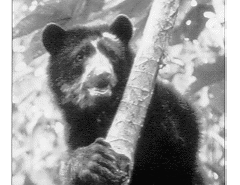
 A Spectacled Stare |
Tremarctos ornatus
short-faced bear
|
The spectacled bear gets its name from the distinctive circular bands which ring its eyes. The markings vary slightly from bear to bear, but the general look is the same. The markings are a creamy-yellowish color while the rest of the fur on the animal could be anywhere from brown to black. The spectacled bear is a small animal as bears go, the males generally weighing from 220 to 340 pounds, and the females 140 to 180 pounds. The animals are generally from 60-72 inches in length, with the females being about 30% smaller, on average, than the males.
The females are generally mature somewhere between their 4th and 7th years. After maturity, the animals will mate between May and June, with the litters of up to 3 being born during the Nov-Feb period. The cubs weigh a mere 10-11 1/2 ounces at birth. During the mating months, the bears will pair up and stay together for up to two weeks, copulating frequently. Like most other bears, the female requires this stimulation to ovulate.
Apart from basic mating and other minor habits, we have no information on the social life of these animals in the wild. The bears that have been studied in captivity have shed some light on their society. Females and cubs communicate with vocalizations, of which somewhere between two and five calls have been identified (depending on which source you check with).
The spectacled bear is a very adaptable animal. It, like the brown bear, is found in widely varying habitats. This bear is found in steppe lands, rainforests, cloud forests, and even coastal scrub desert land. The destruction of its habitat by mankind poses perhaps the greatest threat, since the range of the animal has declined greatly as development of its former habitats has increased.
This bear is found throughout the forested mountain areas of South America. All the way from Venezuela and Columbia, through to Ecuador, Peru, and on into Bolivia. Generally, these animals remain at altitudes of 6,000 - 8,000 feet, but they have been found from 600-13,800 feet as well.
The spectacled bears eat a wide variety of food, ranging from mice, rabbits, birds, berries, grasses and orchid bulbs all the way to their favorite food, the leaves, bases, and hearts of the Bromeliacae plant family. Many times, these animals will climb cacti to taste of the fruit at the top. Similarly, they will build nests in the tops of trees to use as a crude form of feeding platform as well as a sleeping place and day bed.